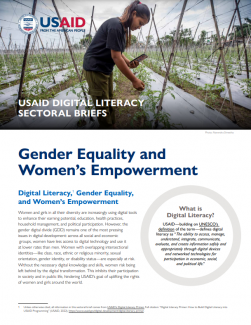Women and girls in all their diversity are increasingly using digital tools to enhance their earning potential, education, health practices, household management, and political participation. However, the gender digital divide (GDD) remains one of the most pressing issues in digital development: across all social and economic groups, women have less access to digital technology and use it at lower rates than men. Women with overlapping intersectional identities—like class, race, ethnic or religious minority, sexual orientation, gender identity, or disability status—are especially at risk. Without the necessary digital knowledge and skills, women risk being left behind by the digital transformation. This inhibits their participation in society and in public life, hindering USAID’s goal of uplifting the rights of women and girls around the world.
Download this briefer to learn more about digital literacy in the context of gender equality and women's empowerment.

